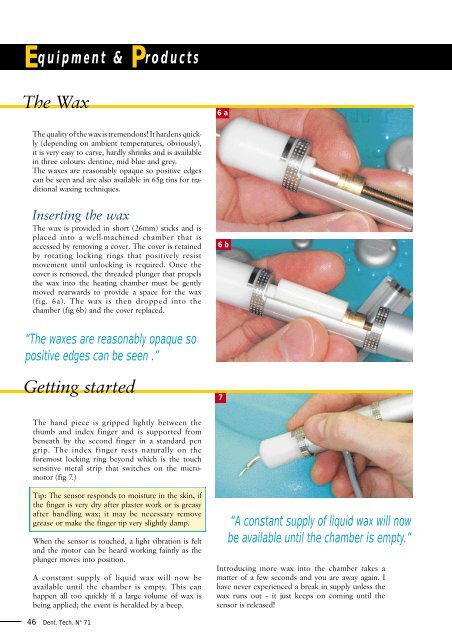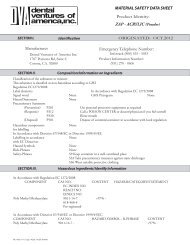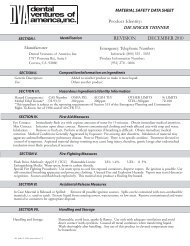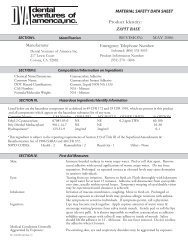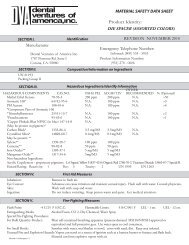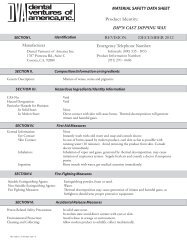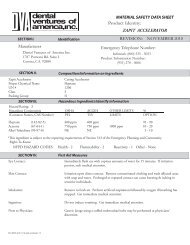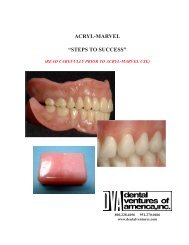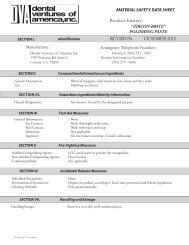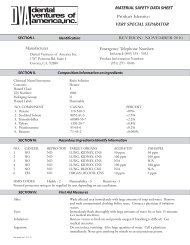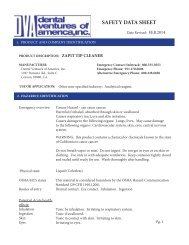DVA's Liquid Waxer system featured in Dent. Tech. - Dental Ventures
DVA's Liquid Waxer system featured in Dent. Tech. - Dental Ventures
DVA's Liquid Waxer system featured in Dent. Tech. - Dental Ventures
Create successful ePaper yourself
Turn your PDF publications into a flip-book with our unique Google optimized e-Paper software.
E q u i p m e n t & P r o d u c t s<br />
The Wax<br />
6 a<br />
The quality of the wax is tremendous! It hardens quickly<br />
(depend<strong>in</strong>g on ambient temperatures, obviously),<br />
it is very easy to carve, hardly shr<strong>in</strong>ks and is available<br />
<strong>in</strong> three colours: dent<strong>in</strong>e, mid blue and grey.<br />
The waxes are reasonably opaque so positive edges<br />
can be seen and are also available <strong>in</strong> 65g t<strong>in</strong>s for traditional<br />
wax<strong>in</strong>g techniques.<br />
Insert<strong>in</strong>g the wax<br />
The wax is provided <strong>in</strong> short (26mm) sticks and is<br />
placed <strong>in</strong>to a we l l - m a ch<strong>in</strong>ed chamber that is<br />
accessed by remov<strong>in</strong>g a cover. The cover is reta<strong>in</strong>ed<br />
by rotat<strong>in</strong>g lock<strong>in</strong>g r<strong>in</strong>gs that positive ly re s i st<br />
m ovement until unlock<strong>in</strong>g is re qu i red. Once th e<br />
cover is removed, the threaded plunger that propels<br />
the wax <strong>in</strong>to the heat<strong>in</strong>g chamber must be ge n t ly<br />
m oved re a rwa rds to provide a space for the wa x<br />
( fig. 6a). The wax is then dropped <strong>in</strong>to th e<br />
chamber (fig 6b) and the cover replaced.<br />
6 b<br />
“The waxes are reasonably opaque so<br />
positive edges can be seen .”<br />
Gett<strong>in</strong>g started<br />
7<br />
The hand piece is gripped lightly bet ween th e<br />
thumb and <strong>in</strong>dex fi n ger and is supported fro m<br />
b e n e a th by the second fi n ger <strong>in</strong> a sta n d a rd pen<br />
grip. The <strong>in</strong>dex fi n ger re sts natura l ly on th e<br />
fo re m o st lock<strong>in</strong>g r<strong>in</strong>g beyond which is the to u ch<br />
s e n s i t i ve metal st rip that switches on the micro -<br />
motor (fig 7.)<br />
Tip: The sensor responds to moisture <strong>in</strong> the sk<strong>in</strong>, if<br />
the f<strong>in</strong>ger is very dry after plaster work or is greasy<br />
a fter handl<strong>in</strong>g wax; it may be necessary re m ove<br />
grease or make the f<strong>in</strong>ger tip very slightly damp.<br />
When the sensor is touched, a light vibration is felt<br />
and the motor can be heard work<strong>in</strong>g fa<strong>in</strong>tly as the<br />
plunger moves <strong>in</strong>to position.<br />
A constant supply of liquid wax will now be<br />
available until the chamber is empt y. This can<br />
happen all too quickly if a large volume of wax is<br />
be<strong>in</strong>g applied; the event is heralded by a beep.<br />
“A constant supply of liquid wax will now<br />
be available until the chamber is empty.”<br />
I n t roduc<strong>in</strong>g more wax <strong>in</strong>to the chamber ta kes a<br />
matter of a few seconds and you are away aga<strong>in</strong>. I<br />
have never experienced a break <strong>in</strong> supply unless the<br />
wax runs out – it just keeps on com<strong>in</strong>g until th e<br />
sensor is released!<br />
46 <strong>Dent</strong>. <strong>Tech</strong>. N° 71


